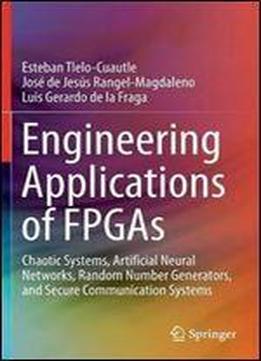
Engineering Applications Of Fpgas: Chaotic Systems, Artificial Neural Networks, Random Number Generators, And Secure Communication Systems
by Esteban Tlelo-Cuautle /
2016 / English / PDF
19.7 MB Download
This book offers readers a clear guide to implementing engineering applications with FPGAs, from the mathematical description to the hardware synthesis, including discussion of VHDL programming and co-simulation issues. Coverage includes FPGA realizations such as: chaos generators that are described from their mathematical models artificial neural networks (ANNs) to predict chaotic time series, for which a discussion of different ANN topologies is included, with different learning techniques and activation functions random number generators (RNGs) that are realized using different chaos generators, and discussions of their maximum Lyapunov exponent values and entropies.
Finally, optimized chaotic oscillators are synchronized and realized to implement a secure communication system that processes black and white and grey-scale images. In each application, readers will find VHDL programming guidelines and computer arithmetic issues, along with co-simulation examples with Active-HDL and Simulink.
The whole book provides a practical guide to implementing a variety of engineering applications from VHDL programming and co-simulation issues, to FPGA realizations of chaos generators, ANNs for chaotic time-series prediction, RNGs and chaotic secure communications for image transmission.Authors: Tlelo-Cuautle, Esteban, Rangel-Magdaleno, Jose, de la Fraga, Luis Gerardo
Provides a practical guide to implementing a variety of engineering applications using FPGAs
Demonstrates use of FPGAs for real applications, such as chaotic noise generators, artificial neural networks, random number generators and secure communications for processing audio and images
Includes VHDL programming guidelines and issues, along with co-simulation examples with Active-HDL and Simulink
This book offers readers a clear guide to implementing engineering applications with FPGAs, from the mathematical description to the hardware synthesis, including discussion of VHDL programming and co-simulation issues. Coverage includes FPGA realizations such as: chaos generators that are described from their mathematical models artificial neural networks (ANNs) to predict chaotic time series, for which a discussion of different ANN topologies is included, with different learning techniques and activation functions random number generators (RNGs) that are realized using different chaos generators, and discussions of their maximum Lyapunov exponent values and entropies.
Finally, optimized chaotic oscillators are synchronized and realized to implement a secure communication system that processes black and white and grey-scale images. In each application, readers will find VHDL programming guidelines and computer arithmetic issues, along with co-simulation examples with Active-HDL and Simulink.
The whole book provides a practical guide to implementing a variety of engineering applications from VHDL programming and co-simulation issues, to FPGA realizations of chaos generators, ANNs for chaotic time-series prediction, RNGs and chaotic secure communications for image transmission.
Number of Illustrations and Tables
74 b/w illustrations, 130 illustrations in colour
Topics
Circuits and Systems
Processor Architectures
Electronics and Microelectronics, Instrumentation











